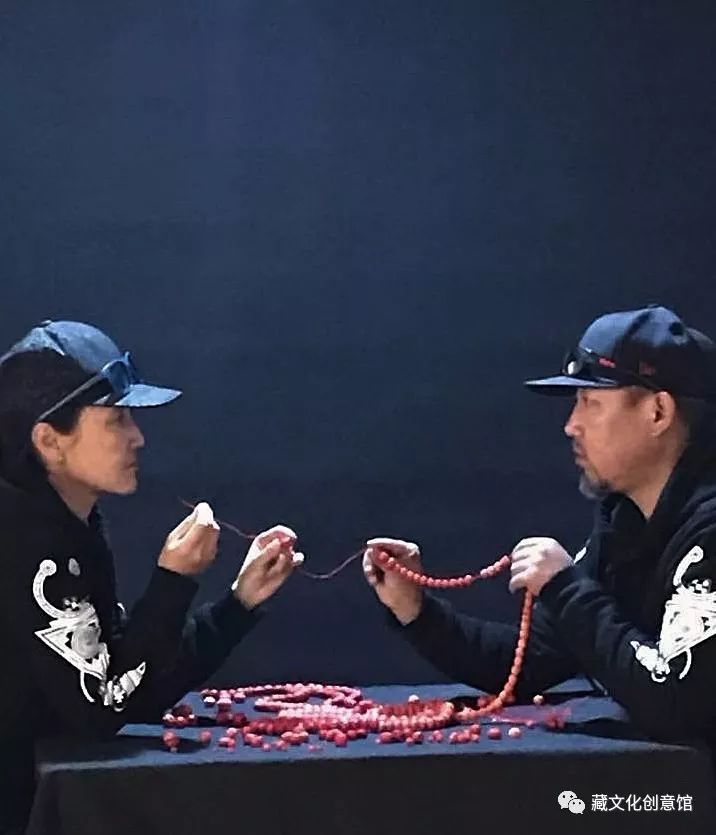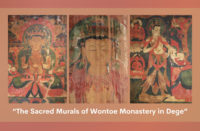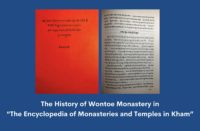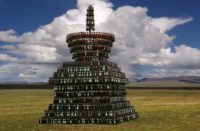
High Peaks Pure Earth has translated a profile of Lhasa-based Tibetan artist couple Langdun Dedron and Tsering Namgyal. The profile was published on July 30 2018 on the WeChat channel of the Creative Centre for Tibetan Culture and was written by Dekyi Dolma.
Even though Langdun Dedron was previously briefly profiled as part of the 2017 “HER” exhibition highlighting five Tibetan female artists, this is an interesting feature as it shows a husband and wife team working both together and individually.
Watch a short video of Dedron talking about herself and her work here: https://audio-video.shanti.virginia.edu/video/gendun-choephel-artists-guild-interview-16-dedron
“Their Love is Admirable, Their Creative and Artistic Talent Even More So”
By Dekyi Dolma, Creative Centre for Tibetan Culture
July 30, 2018
I met this married couple in Lhasa.
Their lives, love, work and hobbies are completely interwoven; two people living in a close relationship that is so much more complicated than love.
24 hours a day, they share their most amazing talents, but they also produce differences in their artworks, which constantly pushes the limits of their intimate relationship.

In the name of love, they spend their lives creating together; and through their artistic cooperation, their love has become deeper and deeper. They have come to be known as “Tibet’s Condor Heroes”.
They told us how it feels to be doing the thing that one likes most with one’s loved one.

Tsering Namgyal was born in 1976 in a unique semi-agricultural and semi-nomadic area of Tibet.
At the age of 8, he did not yet know that the scenery he saw could be portrayed by means of a paintbrush, he had also not yet encountered any art work.
When he was 8 years old, his whole family moved to Lhasa. When they went to a monastery, he saw colourful murals, displaying various different forms and patterns for the first time. He felt a kind of joy that he had never felt before.

From this moment, he realised that he could draw all those things that he has imagined and seen.
From this moment, he would often go to the monastery on his own; every time he stood in front of the old murals, he could not leave, it was like looking at the delicately portrayed characters of a graphic novel, including their movements and expressions.
It was also at this moment that the artistic seed was planted in his heart.

His wife, Langdun Dedron, was also born in the 1970s in Nyemo county of Lhasa. She became the only female artist in her family, a leading clan of the Gelugpa school of Tibetan Buddhism. Langdun is her family name.
In 1985, Dedron’s father was worried about her reclusive nature; in order to give her the opportunity to be in touch with more children of her age, he sent her to a small art class at the Tibet Autonomous Region Mass Art Centre.

There the nine-year-old Dedron started to express the world behind her introverted character, using radiant colours; not long she began to stand out in her class and won a prize in a national painting competition for children the same year.

From a young age, Tsering Namgyal wanted to become a painter and he studied hard and diligently for this, determined to go and study at an art college.
Langdun Dedron, on the other hand, came to painting unintentionally and with the help of her father.

In 1994, both passed the exam to enter the Fine Art Department of Tibet University and from that moment set foot into the sacred palace of painting and drawing.
And as fate wanted, the two became classmates and their love for each other slowly developed.

In their class at university, Tsering Namgyal was lively and energetic; Langdun Dedron, in contrast, was quiet and introverted, she never liked talking too much. When they first started going out, many people did not see a happy ending.
But time told everyone that they not only became an intimate couple that helped each other accomplish their aims, they also became best friends; they were tolerant and learned from each other.
“What moved me most was when he waited for me outside the dormitory; rushing towards him was like rushing towards my future,” Langdun Dedron remembered.

At university, they studied a broad range of things, including thangka, oil painting, ink painting, sculpting, design and so on. This had an enormous impact on their later artistic developments.
When they started their careers, during the first two or three years, they copied murals; after that, they started creating their own works. With the brush in their hands, they went on, like pilgrims, to devote themselves to understanding the aesthetics of Tibetan culture.

In an unknown art world, they wanted to use traditions to explore and try new ways and forms and from within, touch upon the spiritual world and human beings’ origins and essence.

In 2003, they got married. Today, they are parents.
Their life as a married couple has been peaceful and well-organised, but still full of many ordinary surprises. Ordinary, because life itself is essentially ordinary, it is the surprises that linger on.

Having grown up in Tibet, they are deeply entangled with Tibetan culture and it is only natural that they harbour a deep love for Tibetan people and the Tibetan land.
Their works reflect this. It can be parents and brothers and sisters who live together day and night. Under their brushes, they radiate and reflect the strong colours that are unique to Tibet.
It can be strong and steady black yaks; it can also be the auspicious red-crowned cranes flying above the holy city.

For those visiting Tibet for the first time, it is a mysterious place, the holy land of Buddhism. But for Langdun Dedron, it is a cute place, full of childhood memories.
Children running in the sun, their faces smudged with plateau red, are symbols of innocence and faith or of the clouds floating in the blue sky, even in the eyes of elderly people who have experienced vicissitudes of life.

Langdun Dedron wanted to express these most ordinary yet also most lovable moments in life and so she adopted a cartoonish colour to portray Tibet.
Her paintings are playful and abstract, like the pair of talking big eyes; she continues to use traditional Tibetan mural techniques and seeks to change expressions and content, showing the changes in Tibet and the new face of Tibetan women.

Creation is a mirror that never lies; when you see someone’s work, you can often see the creator behind it.
People from their generation carry with them a cultural anxiety. For Tsering Namgyal and Langdun Dedron, the interpretation of traditional culture and worship of the past is often in vain, it feels like you are understanding, but are not actually understanding and there is not enough time and energy to really learn and understand the past.

On the other hand, changes in Tibetan society have been immense, many old objects have gradually become obsolete and gradually left our lives.
They felt strongly that one should collect some old objects to show to their children what fellow Tibetans used to use in their lives. This idea eventually turned into a form and source of inspiration for their artistic work.


Tibetan traditions pervade all their artworks, while also exuding a new kind of energy.
Tsering Namgyal and Langdun Dedron’s attitude towards Tibetan culture also reflects this, “You pass on, you transmit until things end up in a museum.” The two repeatedly emphasise that “You cannot always remain with our old ancestors. Development is more important, you have to completely integrate with the contemporary era. Otherwise, you will always be at the margins and eventually fade away.”

For them, traditional culture is as beautiful and vulnerable as the world of Pandora.
Fortunately, their son has also been influenced by them and has a good understanding of traditions.
Tsering Namgyal once said, “They always collect various ethnic objects and every year when my son celebrates his birthday, they give him something as a gift, it is a custom of Dedon’s father. For us, this is also a form of transmission. We hope that our son will also cherish them, that he will cherish our traditional culture.”

You never waste efforts in life, success is never random. Brush, paper and pigments are an inseparable part of their lives.
Their lives harbour the books they have read, the paths they have walked, the people they have loved, the nights they have spent creating art, the days they have spent and the tea they have drunk; all of this together makes up the rich life they share.
Today, the two are internationally well-known Tibetan contemporary artists. Their works have been exhibited at the Rubin Museum of Art in New York, at the China National Art Gallery, the Today Art Museum, the Rossi and Rossi Gallery in the UK, the Yuxin Art Gallery in Singapore as well as in exhibitions in Italy, Germany and France. Many of their works have been collected by museums in China and abroad.
Tsering Namgyal’s Installations:
Langdun Dedron’s drawings:


















Tashi delek
This is Kesang Lamdark
From switzerland Zürich
🤘🙏🏽🙏🏽🙏🏽🙏🏽🫡🫡🫡❤️❤️👌👌👌